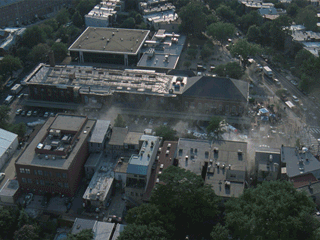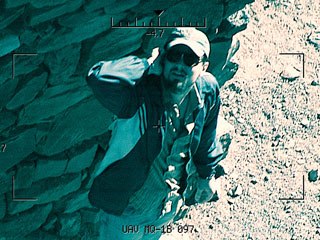For Body of Lies, the latest spy thriller by Ridley Scott, Sony Pictures Imageworks goes into stealth mode, but Jack Egan uncovers the vfx secrets.
In Body of Lies, the just-released film from veteran director Ridley Scott, the visual look throughout is a gritty verisimilitude to add authenticity to the movie's plot about the deceptive and deadly cat-and-mouse games played by a CIA operative in pursuit of terrorists in Iraq and Jordan.
Upon viewing, there seem to be few CG visual effects employed in Lies, which stars Leonardo DiCaprio as the undercover agent and Russell Crowe as his crassly obsessive CIA handler. Though limited, vfx does play an important role in several key sequences. They include a flower market explosion set in Amsterdam and a complex desert chase involving cars and helicopters. In addition, a scene that takes place at what's supposed to be the Incirlik Air Base in Turkey was created digitally.
VFX Supervisor Sheena Duggal and her team at Sony Pictures Imageworks get props for seamlessly integrating the CG scenes with the shot footage. Duggal recently talked to VFXWorld about the challenges of the job. "We wanted to be smart about how we approached the visual effects in the film, because it's not a visual effects driven movie -- the visual effects are really just there to help the story," notes Duggal. Sony Imageworks worked on about 50 effects shots. Invisible Effects (supervised by Dick Edwards) accounted for another 150, and Imageworks India also was involved.
"One of the things I realized from the bidding stage -- I've worked with Ridley before on Matchstick Men so I had a sense of how he works -- I knew that atmospheric effects was going to be a really important part of this project for us," says Duggal. "I don't think there's a shot in the film that we worked on that doesn't have lots of vfx animation stacked in there elements like smoke and dust layers."
As for software, Flame and Shake were used for compositing, and Maya for 3D animation. Houdini was used to run the volumetric simulations (describes the forces of the explosion). The simulations were then rendered in Svea.
Duggal was in Morocco where most of the film was shot, as well as in Washington, D.C., which substituted for Amsterdam for the flower market explosion. "When we were on set we knew that some of these visual effects were going to be more complicated than others," she adds. "We were trying to be cognizant of the vfx budget, and then figure out what was most effective for Imageworks to do in post."
Imageworks post took a brief seven weeks and the complex 2D and 3D shots were done primarily at Sony Pictures Imageworks. The rest of the shots which involved monitor burn-ins and graphics, and some of the 2D matte paintings, were done at Invisible Effects.
The Amsterdam market explosion and destruction, set off by a bomb inside a car, is one of the film's highlights. It features pulsing shock waves that have an almost physical impact for the viewer. For starters, footage was shot of an actual explosion. "We filmed some TNT blowing up in Morocco," she says. "We captured these incredible shock waves on film, and Ridley really liked this effect and wanted to incorporate it."
The blast for the film was a digital explosion. It was created by Dr. Patrick Witting, an expert in fire and smoke simulations. The simulation was then rendered on an in-house renderer called Svea. The Compositor Jason Greenblum and Effects Animator Bjorn Zipperich, working with CG Supervisor John Monos, added color lighting compositing effects comprised of smoke, debris, shattered glass, and distortion effects from the shock waves.
Director Scott wanted to have the big-impact moment personalized by, including a Japanese tourist couple to absorb the shock of the explosion. Created digitally, they appear in a medium close-up shot that shows them taking photographs; they get hit from the blast. Next: a side view of the explosion where a car gets flipped.
"Overhead aerial shots of the explosion [are] how the audience sees the big shockwave and the big digital explosion," notes Duggal. "Those are all effects." The couple being blasted was shot in several plates. "We had a plate that was just a live-action shot, and then we had a plate where we rigged dummies and there were special effects rigged in the vehicle." In post, the compositing package was used to blend and morph the two plates to make it look realistic. Then the wires and all the rigging were removed.
In the next shot, the car flips, and its windows shatter, along with the glass in the windows of the building behind. Computer-generated enhancements create an atmosphere of smoke, dust and bits of debris flying toward the camera. Next, in the aftermath of the explosion, fire engines and emergency vehicles arrive.
That was used as an "aftermath shot," says Duggal. Elements were removed from the plate that were not in the context of the shot. A 3D matte painting was done by Rob Stromberg , which is a view over the city's canals and barges. This was then tracked that into the live action helicopter plate. "Once all of that extraneous matter was removed by Imageworks India, digital people from Imageworks digital character library were inserted, and we also applied some motion capture that emulated the performance we needed which was of people ducking from the explosion."
A major scene involving lots of vfx is the desert car chase. The sequence incorporates two helicopters firing missiles, and three SUVs that are firing rocket propelled grenades. The scene, which was shot in southern Morocco in the Sahara desert, has a lot of invisible effects in it. "We choreographed the sequence in post to create a lot of the timing and pacing that Ridley and editor Pietro Scala were looking for," notes Duggal.
Visual effects shots were added to the fast-paced action that helped to make it clear who was firing at whom. Vfx was employed to adjust the relationship between the three cars and the two helicopters. "You're looking from the point of view of the lead car and you're looking back and seeing the cars behind and also the helicopters," Duggal explains. "We moved all of those spatially within the image."
For safety reasons, the car explosions in the chase sequence were shot in multiple passes. "We would shoot a pass with a moving foreground SUV," she notes. "Then we would have a stationary SUV that would explode. And then we would fly helicopters through. Finally we would have an extreme background explosion. All of these elements were then composited together in post which was quite tricky. We would add on to that the RPGs and the missiles."
To shoot the plates, it had to be determined where each car would be relative to the others at the time of the explosion. "And then we went back and rigged the cars in their static positions and blew them up," says Duggal. For this sequence, multiple cameras were used, including an additional aerial cam. In one shot in the car chase, a fully CG SUV was created along with the debris and most of the explosion. "We used the plates that we had shot on the location, we combined the passes to get the elements that we needed in the base plate, then we added a simulated explosion, fire, debris, the fully photorealistic CG SUV, dust, dirt and even the CG bouncing tires."
Working with Animator Koji Morihiro and with Scott, realistic weight dynamics were created. "That was something Ridley was very passionate about -- that the SUV was impacting heavily enough to be real," says Duggal. "And we also added the CG SUV into some other shots in the sequence that we repurposed. By taking a plate and removing some of the live action elements and changing the relationship between the cars and the helicopters and then adding CG elements to that, we gave Ridley and Pietro much greater flexibility about what they could in terms of storytelling."
The brief scene at the Incirlik Airbase in Turkey involved several totally digital shots. A helicopter flies in, which is followed by a cut to live action footage of it landing, and then bodies are brought out. Then there's an explosion at the airbase. "We talked about going to the desert to create it and shoot it, but Ridley decided that we could do this digitally and that it would be more cost effective," says Duggal.
Added to a 3D matte painting done by Stromberg was a CG Humvee and a CG helicopter for the shot when it flies in. The base starts blowing up, depicted in a fully CG explosion with added debris, smoke, fire and digital distortion creating, once more, shock waves.
"One of the great things about working with Ridley is that he has such a great visual sense" says Duggal, noting the director also has gifts as an illustrator. "He's an artist, so he's able to articulate and draw the picture of what it is he's thinking." On the set and during shooting "he'll do a Ridley gram as we call it, a little drawing, at the time shooting is going on," she notes. "When you're in post he has the same idea in his head or he'll create the same doodle-it's pretty impressive. It allows us to focus on getting the shot done creatively and not have to do many, many iterations to see what he wants."
Duggal, one of the few female vfx supervisors, is originally from Manchester, England. She is on the board of the Visual Effects Society technology committee. She was visual effects plate supervisor on Spider-Man 3; her other vfx supervisor credits include Matchstick Men, Anger Management and Men in Black II. Currently Duggal is working with Imageworks and Sony Pictures Animation developing possible future projects.
Jack Egan has written about the film and television business, from both the corporate and creative side, for over two decades. He was New York business correspondent for the Washington Post, a columnist for New York Magazine, assistant managing editor at U.S. News & World Report and a senior editor at Forbes. His articles have also appeared in Variety, the New York Times, Directors Guild Quarterly, Creative Screenwriting, cgsociety.com and Below the Line. This is his maiden effort for VFXWorld.










